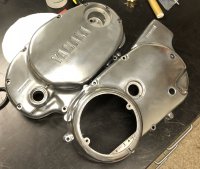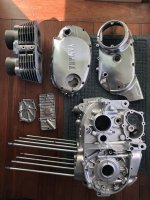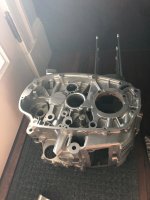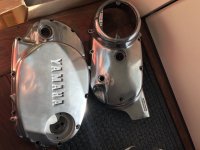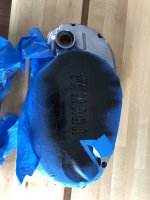Top end - Valves, Cam and Followers:
Cleaned up the valves as best I could, but have to say they don't seem to get nearly as clean as everything else. I tried my hand at valve lapping. I made a video of my technique for doing this, using techniques described on this forum and some internet videos, and it seemed to be pretty effective. I was looking to see a consistent polished 'face' around the valve and in the seat. After lapping, I didn't see any pits, so I assumed this meant my valves were sufficiently lapped.
I went back and forth on trying to DIY it or actually buying a valve spring compressor, after seeing quite a few clever solutions posted across this forum and elsewhere. I think I found one for like $16 shipped, and while I know it's not exactly an heirloom tool, this felt like money well spend for this build, especially considering I don't have a welder here. I checked the free length of the springs and all were within spec, so felt OK to reuse. After re-installing the valves, I did a leak test using some mineral spirits in the ports. I saw some light seepage after a few minutes, but nothing drastic, and given the wicking properties of a solvent like that, I don't know that I would expect a perfect seal forever anyways. Some before and after pics are here as well.
Then install the head
Reinstalling the cam was pretty straightforward, paying close attention to the timing mark on the sprocket at 12:00 as well as the dot lining up with the head at 9:00. Jim's top end thread does a great job illustrating this. It was a little fussy getting the endless cam chain around the sprocket and I used some sockets to lightly torque down the head to give some extra play, and then slip the dual bearings over each end.
Follower/rocker arms was next....straightforward EXCEPT to make sure the shafts are facing the correct way with the threaded access hole facing out. Not sure if they can go in the other way (?) but it seems like it would have been a really regrettable mistake to get that wrong. Little assembly lube on each before install.
One tip I found that was very helpful was (I believe) in Jim's thread.....re-installing the points/advance housings on each end of the cam shaft to center the cam and bearings before torquing the head bolts down with the specified torque pattern. You can see the new rubberized washers I opted for, although they were a little pricier than the copper ones I've seen others use.
Motor is almost done and nothing has cracked or exploded (yet!). I was feeling both accomplished and apprehensive at this point, but I could turn the crank by hand (well, strap wrench) and everything moved freely, so I felt that was at least headed in the right direction



